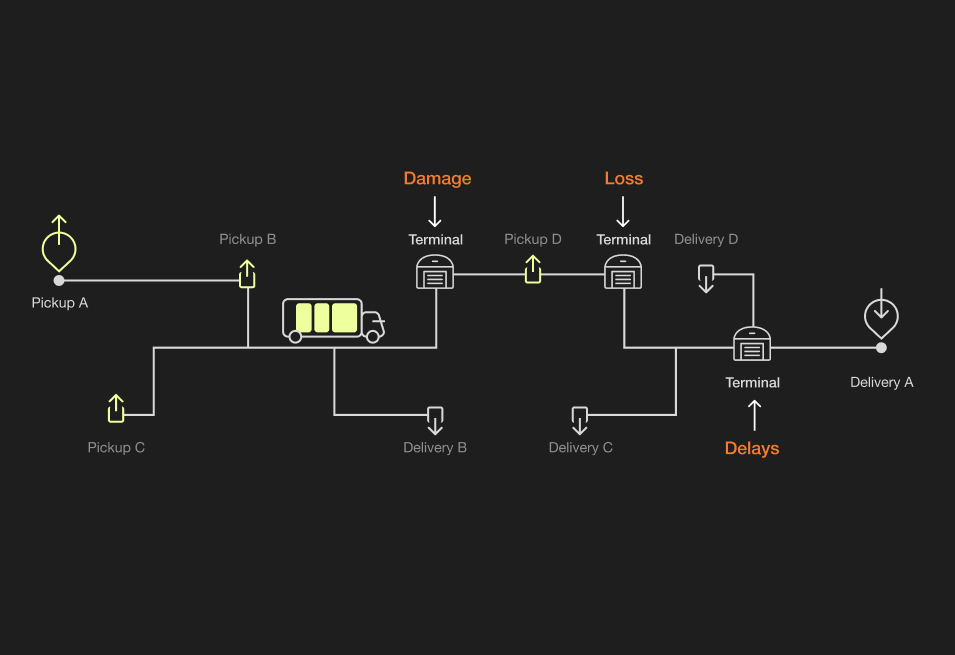Spot Rates vs. Contract Rates

Securing the best loads is crucial to running a successful freight business, so it’s extremely important to understand the nuances of spot rates vs. contract rates and the best time to use each.This article covers:
- what spot rates and contract rates are
- how the prices of each are determined
- the advantages & disadvantages of both
- how to decide which type of rate to secure
Defining freight contract rates vs. spot rates.
Contract rates and spot rates are the two ways in which carriers agree to move shippers’ freight. For both shippers and carriers, utilizing these rates effectively is crucial for maintaining profit and staying competitive in the industry.
What is a contract rate?
A contract rate is a pre-negotiated rate between a shipper and a carrier for a specific route for a designated amount of time, typically six months to a year. While not exclusively, companies that ship higher volumes on consistent schedules and routes frequently utilize these set rates.
What is a spot rate?
A spot rate is the cost of moving one shipment on a specific route at a specific time.Because they’re a one-time rate offering a lot of flexibility, they’re often necessary for companies without regular shipping schedules or routes. However, many companies also utilize them to move freight outside of their typical contracts, such as when they have excess supply.
How freight rates are determined.
While determining trucking rates involves many factors, there are a few aspects always considered in price calculation, no matter the rate type. These elements include:
- Freight characteristics: the cost is higher in instances when bulky, heavy, fragile, or hazardous freight needs special handling or equipment
- Mode: various modes will incur very different rates
- Route: long routes need more fuel; thus, they cost more
- Service needs: shipments that are expedited, have strict delivery windows, or need special equipment to deliver are more expensive
How are contract rates determined?
In addition to the universal factors above, a contract rate’s price is influenced by:Volume.Because it's logistically beneficial for carriers to coordinate with less shippers and to plan capacity and budgets effectively, shippers with higher freight volumes often get lower rates.Length of agreement.In order to anticipate income, many carriers value consistency, so typically the longer the contract, the better the rate.RFP completion.Contract rates are typically decided after an RFP process during which multiple carriers bid to secure a shippers’ freight. During this process, carriers can out-bid each other to win the load, often driving down the final cost.
How are spot rates determined?
As for spot rates, in addition to characteristics, mode, route, and service needs, cost is largely determined by market conditions such as:Demand & driver capacity.When the economy is healthy and consumers collectively purchase a high amount of goods, there is high demand for carriers – meaning there are fewer available drivers than shipments needing to be moved. In this type of market, carriers can charge shippers more, which increases the cost of spot rates. On the flip side, if there is a low demand for carriers, that means there are more drivers available than there are shipments to move – so carriers will often lower their rates just to secure loads.Fuel costs.The current market price for fuel is another major factor in determining spot rate pricing. Because carriers need to cover their operating costs, when fuel costs increase, so do spot rates.Pickup and dropoff locations. Wanting to minimize deadhead miles, aka miles driven with no freight, carriers will negotiate higher rates to deliver to a location where it will be harder for them to find a return load, known as ‘backhaul’.
Comparing spot rates vs. contract rates.
Offering different benefits and challenges, understanding the upsides and downsides of each rate type will help you determine which one to secure to meet your needs.
What are the advantages & disadvantages of spot rates?
While perhaps spot rates’ largest benefit is flexibility, they offer many other benefits as well as challenges.
Advantages of spot rates.
Flexibility.Need to fill in some gaps with a little extra profit? The one-time nature of spot rates is an easy way to do so without taking on a longer commitment. They’re especially lucrative to pick up in markets with fewer drivers available than the amount of freight that needs to be moved because shippers will pay more to have their goods delivered.Diverse network.Using spot rates to boost your shipper network reduces your reliance on a few customers or limited routes – offering a safety net if those contracts end while also opening you to potential new long-term opportunities.Competitive advantage.Diversified offerings help you stand out from competitors, encouraging shippers to work with you as opposed to another carrier who only offers contract rates.Market insights.Utilizing spot rates gives you insight into current demand and pricing trends, making it easier for you to make more informed decisions when allocating capacity or setting new rates.
Disadvantages of spot rates.
Price variability.While a great benefit in certain markets, when the market turns to be more shipper-favored, you risk struggling to find well-paying loads. Uncertainty.Because of price variability, utilizing spot rates – and especially relying on them as your main source of revenue – makes it challenging to accurately plan your capacity and profit.Additionally, while working with new shippers can provide a great networking opportunity, there’s always the risk that they’ll be difficult to work with and create added challenges.
What are the advantages & disadvantages of contract rates?
While often preferred for their reliability, that rigidity creates the biggest challenge with contract rates.
Advantages of contract rates.
Predictability.Anticipating your profit and schedule allows you to effectively create a budget and allocate resources. Plus, knowing what to expect when working with familiar shippers and routes makes things run more smoothly.Reduced administrative burden.This customer loyalty reduces the amount of time spent finding new loads, negotiating prices, filing paperwork, and other laborious tasks.
Disadvantages of contract rates.
Limited flexibility.Because contract rates are a committed price for a committed amount of time, there’s not much room for change until the contract ends – which can negatively affect profitability. If your entire fleet is spoken for for contracts, you may miss out on additional income from flexible spot rates.
How to choose between spot rates vs. contract rates.
When deciding which rates to secure, consider both your business priorities and what’s currently happening – and is predicted to happen – with the market.
Decide business priorities.
With benefits and downsides to each rate type, the best one to use is highly dependent on what you consider to be your most important priority. If you’re looking for:
- predictability: secure more contract rates
- flexibility: prioritize spot rates
- low cost: depends on market conditions when making your decision
In most cases, it’s wise to secure a mix of each rate type to reap the benefits of both and to protect yourself from the downsides of fully relying on just one.If you solely secure spot rates, you can face:
- wildly unpredictable profit and resource allocation
- difficulty securing well-paying loads if the market turns in a shipper-favored direction, considered a deflationary market
As for only securing contract rates, you risk:
- the inability to secure higher-paying loads if the market shifts to favor carriers, known as an inflationary market
Consider market conditions.
What’s happening in the market drastically influences when is ideal for securing spot rates vs. contract rates and vice versa.
Inflationary markets.
2021’s surge in consumer demand resulted in major supply chain disruptions and a shortage of drivers to keep up – classifying the year as a carrier-favored inflationary market. With so many goods to be moved and limited carriers to move them, shippers were willing to pay more.Because shippers will splurge in these inflationary markets, they’re an ideal time for carriers to utilize higher-paying spot rates.
Deflationary markets.
In 2022, consumer buying habits slowed given the rising inflation rate and global trade that seemed to come to a halt – creating a shipper-favored deflationary market. With an excess of carriers wanting to secure the minimal amount of available shipments, many carriers had to severely lower their prices just to get any income.Anticipating an impending deflationary market and securing contract rates before it arrives while prices are still high locks carriers into earning more during an otherwise challenging time.
What’s happening with rates in 2023?
2023 spot rates.As of early 2023, spot rates continue to lower. If truckload prices continue to slide, helped along by a decline in diesel prices, then mid-2023 will mark the bottoming out of spot rates – which may then start rising in the final months of 2023 at the earliest. If demand goes up, rates could increase sooner, but it looks unlikely.2023 contract rates.Contract rates have also fallen – dropping to their lowest since 2020 – and are expected to continue to fall before rising in early spring 2024.What 2023’s rates mean for carriers.With spot rates and contract rates low, so far, 2023 has leaned more favorable for shippers – but that is expected to start shifting in the coming months.Our current outlook on:
- spot rates: while right now is not an ideal time to secure them, later this year looks like it will be more lucrative
- contract rates: look into securing them once they rise again – which is looking like that may be in early 2024
NOTE: With the market in constant fluctuation, these predictions can change. In order to get the best rates, it’s very important to keep an eye on when these shifts officially occur.Let Flock help you make informed business decisions by easily staying up-to-date with all things freight. Get industry insights and market predictions delivered right to your inbox by subscribing to our newsletter, The Haul.
Secure the best spot rates with Flock.
By combining freight from multiple shippers to fill trucks’ empty spaces, Flock Freight’s patented shared truckload technology earns you up to 20% more per haul – making maintaining profit easier in today’s challenging deflationary market.Plus, the Flock platform puts a stop to endless scrolling with tailored load suggestions based on your preferences. Easily keep moving and earning with ideal freight that finds you.Join the Flock to start effortlessly earning more today.





